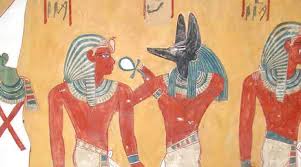
King Tuthmosis IV was the 8th pharaoh of the Eighteenth Dynasty. His father was Amenhotep II and his mother was Queen Mutemuya, the daughter of the Mitannian King who produced the heir to the throne Amenhotep III. King Tuthmosis IV is most famous with his dream stela. His tomb KV 43 was first entered in 1903 by the Egyptologist Howard Carter (discoverer of the Tomb of Tutankhamun KV 62). It is generally similar to that of Amenhotep II (KV 35), but with some differences. The tomb's total area measures about 407.7 m², and its length is about 105.73 m. Some scholars thought that King Tuthmosis IV was buried quickly because of the tomb's poorly decorated walls and its small chambers. Architecture of the Tomb of Tuthmosis IV: The Well Chamber and the chamber preceding the Burial Chamber are the only decorated parts of KV 43.
The scenes show King Tuthmosis IV with various deities such as Osiris, Anubis, and Hathor. We can see a rope used by ancient thieves still lying in the first pillared chamber. On the right (south) wall of the chamber before the Burial Chamber, Maya Horemheb's, the official who was responsible for inspecting and resealing the tomb, left a beautiful calligraphic record of his tour. The decoration on the walls of this chamber is also painted to be like the Well Chamber and this is the first tomb in the Valley of the Kings to have such scenes. The Burial Chamber of the Tomb of Tuthmosis IV consists of two levels with six pillars and is similar to that of KV 35. There is no decoration in this chamber. It houses a red-painted quartzite sarcophagus at the far end of the chamber, decorated with nicely carved hieroglyphic inscriptions. There are four magical niches cut in the lower part of the chamber, one on each wall. There are four side chambers: two are cut into the side walls of the upper level and other two into the side walls of the lower. These side rooms were closed in ancient times and contained food offerings and funerary objects.
